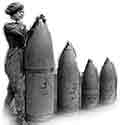
Danger, explosion and fire at a World War One munitions factory

One of the crucial jobs that women stepped in to do while men were away on WW1 war-work was in the manufacture of munitions - tanks, bombs, guns and the like. When there was a fire at factory which made these weapons, there were multiple casualties. This page describes the situation and ensuing emotions from the points of view of children and adults who were there at the time. Personal recollections bring the page to life.
____
Extracted from the memoirs of the webmaster's mother(1906-2002) and edited by the webmaster with further research
Munitions factories
As the country was at war, special factories were set up to produce munitions.
The school in Silver Street, Edmonton, which my brothers and I attended during the First World War was very near the local munitions factory. I don't think we children ever thought about it. We could see that the women who worked there had yellowish skin, but unpleasant as this must have been, it was hardly dangerous. Then one evening the danger was dramatically brought home to us. There was an explosion at the factory!
First signs that something was wrong for us children
As it happened, my brothers and I were alone at the time. Our parents and a friend had gone to the pictures (the cinema). This was the only time I knew them to do so. So I suppose that something special was being shown or that some sort of treat was due. I was 12 and my two brothers were 10 and 14.
My brothers and I had been told to get ready for bed while our parents were out.
My brother Jim went out into the garden to the food safe to get some milk for cocoa, and he came back running, clearly very scared. His face was white with fear and he was breathless.
My brother Ted and I went to see what had happened and saw immediately that the whole sky was lit up.
Just then my parents arrived back. They were breathless and obviously also very scared.
My mother hurriedly told us to put our clothes back on as quickly as we could, to get away.
First signs that something was wrong for our parents
Our mother later told us what had happened from their point of view:
The moment they came out of the Picture Palace [cinema] they were struck by the crowds of people with children hurrying in the opposite direction. These people were shouting that there was a fire at the factory.
So my parents rushed back towards home as fast as they could.
However, when they got near to the Huxley Estate where we lived, they were stopped by police who told them to go back because it was a danger zone. My mother kept on insisting, saying that they must get through because their children were there - and the police eventually let them through.
Explosions, fire and more commotion
My brothers and I dressed quickly and hurried with our parents to a railway bridge where my father thought it would be safe to stand.
All of a sudden there was another big explosion.
My mother's friend went berzerk: she screamed and ran, and my mother ran after her to get her back. Apparently the friend had been on duty at a previous explosion at the Silvertown munitions factory and had never recovered from what she had seen there.
Eventually the sky started to lose some of its colour and my parents decided that it would be safe to return home. This time, the police let us through.
The condition of the casualties
There was a smaller explosion at the factory one afternoon when my father was on duty at the hospital. He would not talk much about it, because it had obviously affected him deeply. He did say, though, that you couldn't tell whether the bodies were men or women because their hair, clothes (and presumably their private parts) had been blown off.
The Edmonton Munitions Factory
The munitions factory was called Eley's and was in Kiln Lane, Edmonton, just behind Silver Street School.
The munitions
The factory produced bombs and mines.
Facts about the major explosion at the factory
These munitions caught fire on the 11th October 1918 at about 9pm. The resulting explosion and further fires were regarded as a major incident. Fire fighting crews were brought in from nearby towns to support the local fire brigade, and roads in the vicinity were closed.
Information courtesy of
Enfield Local Studies Centre & Archive
from a 1978 report by
Major J. D. Sainsbury
If you can add anything to this page or provide a photo, I would be pleased if you would contact me.
By the webmaster's mother (1906-2002) with additional research and editorial work by the webmaster
Text and images are copyright
sources: early 20th century material
sources: ww2 home front and other material
contact
the webmaster/author/researcher/editor
privacy policy
















